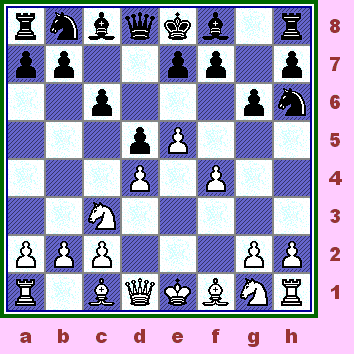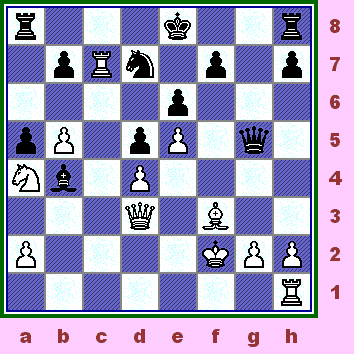Supplementary
Game (# 01) for the
August (2004) / "Game of The Month."
An extraordinary game ... in many,
many different ways. An unusual
opening leads to a very unusual
(I am also pretty sure that this was
a rapid play-off game, played at a
very accelerated time control.)
*****************************************************************************
1.e4 g6;
('!?')
{Diagram?} Almost needless to say - this is a completely "Hyper-Modern" type of opening! *** *** *** *** *** *** *** *** *** *** *** *** *** *** *** *** *** *** *** *** *** ***
Now White - naturally! - grabs the
center, by shoving his QP two (squares).
[ Also fully playable for Black is
the move:
= 2...Bg7;
{Diagram?}
3.Nc3, (develop!)
{Diagram?} [ Another tack for White is to play c2-c4 in this position.
For example:
3.c4 Bg7; 4.Nf3 Nf6;
5.Nc3 0-0; 6.Be2 e5; *************************************************************
In his younger and bolder days,
the great Spassky would often try
the move
Play could now proceed:
3...Bg7; 4.h5 c5;
5.d5 gxh5!?; {Diagram?} ( Or if: 5...Nf6!?; then 6.h6!, "+/=" )
6.Nc3 Bxc3+!?; 7.bxc3 Nf6;
8.f3 Rg8; 9.Ne2! Qa5!?;
(Much safer was >/=
10...Nbd7; {Diagram?}
11.Bd2! bxa4; 12.c4 Qa6!?;
{Diagram?} ( >/= 12...Qc7!; 13.Nf4, "+/=" )
13.Nc3 Bd7; 14.Kf2 Qc8;
{Diagram?}
15.Bf4!! a5!?;
(dubious!) {Diagram?}
16.Bd3! Na6; 17.e5! dxe5;
18.Bxe5 Nb4; {Diagram?}
19.Bxf6 exf6; 20.Bxh7 Rg7;
21.Rxh5 Kf8; 22.Qd2! Bg4!?;
{Diagram?} *******
MANY years ago, I wrote a chess
editor of a state magazine. I asked
him why not Qf4!
23.Bf5!!,
(hmmm) {Diagram?} ( Also winning was: 23.Rh4!, "+/-" )
23...Bxf5; 24.Rh8+ Rg8; 25.Qh6+ Ke7;
26.Re1+ Kd7?; {Dm?}
( Or Black could play: (>/=)
26...Be6!?[]; 27.Rxe6+!! fxe6;
And now the elegant move:
27.Qxf6!,
"+/-" (Nice!!) {Diagram?}
Boris Spassky - Anatoly Ufimtsev;
[ See the most excellent book:
"The Best Chess Games of
Boris Spassky,"
3...c6!?;
4.f4 d5!?; {Diagram?} *********************
[ Black could also play:
4...Bg7!?; 5.Nf3 Bg4!?; {Diagram?}
( Or Black can try the very
wild line of: 5...Nf6!?;
6.Be3 Qb6; 7.Qd2! Bxf3; 8.gxf3 Nd7;
9.0-0-0 Qa5; ( Or 10...b5!?; 11.f5!?, "+/=" {D?} with a solid edge to White. )
11.Rg1 Kb8; 12.Rg5 Qc7; 13.d5 Nb6;
14.dxc6 bxc6;
GM Judit Polgar (2587) -
IM Colin Crouch (2439); [ See MCO-14, page # 371; column # 01, and note # (d.). ] ] *********************
5.e5 Nh6;
('!?') {See
the diagram - just below.} {Black wants the f5-square.}
*************************
*************************
This
is a fairly rare position ...
I could only find about 15 total
games [ Also possible is: 5...h5!?; "~" ]
Both sides continue to develop
in this odd and unusual opening
system. Find this position in your opening books and monographs! I {triple} dare you! [ Also playable was: 8.Qd2!?, "~" ]
8...Nf5;
9.Bf2 e6; "=" 10.Be2 c5!?; (hmmm)
{Diagram?} [ Maybe just: >/= 10...Nd7; "=" ]
11.Na4! Qa5+;
12.c3 Bxf3!; 13.Bxf3 Nxd4!?; 14.Bxd4 cxd4;
[
Black should not play:
</= 15...Qa6?!;
as 16.cxd4!,
"+/=" {D?}
16.cxd4!,
{Diagram?}
[ Less effective was:
</= 16.Qxd4!? g5!!;
"=/+" {Diag?}
16...a5?!;
(hmmm) {Diagram?}
[ Maybe safer was the
continuation of:
17.b5 Bb4+;
18.Kf2 Nd7; 19.Rc1 Qd8; 20.Qd3, "+/=" {Diagram?}
[ Also very good was:
20.Qe2!?,
"+/=" {Diagram?}
20...g5?!;
(Maybe - '?')
{Diagram?}
[ Black should probably play:
>/= 20...Nb6![]; 21.Nxb6 Qxb6;
22.a3 Be7;
21.fxg5 Qxg5;
22.Rc7, {See
the diagram ... just below here.}
*************************
*************************
---> Now Black cannot castle ... as he will hang the Knight on the d7-square.
[
The move of:
22.Qe3!?, "+/="
{Diagram?}
22...Nxe5?;
{Yuk!}
{Diagram?}
[ Black's only move was to
play the forced-looking move
of:
23.dxe5 Qxe5;
24.Rhc1!?, {Diagram?} [ I prefer: >/= 24.Rxb7!, ("+/-") {Diagram?} just grabbing the Pawn here. ]
The rest really needs no comment,
Black has insufficient compensation
for the cavalry unit.
[ The alert move of:
>/=
28.Nc5!,
{Diagram?}
28...h6;
29.Qf6 Qg3+; 30.Ke2 Bb4!?; 31.Rc1 Ba3?; {Diagram?} 32.Rcc7,
("+/-") {Diagram?}
Black Resigns ...
A game of wild positions and hair-raising tactics. Neither King was
really safe in the middle game! ************ Copyright (c) A.J. Goldsby I
1 - 0 |

